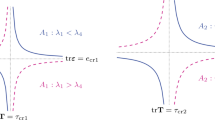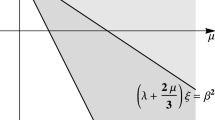Abstract
In a large class of porous elastic solids such as cement concrete, rocks, ceramics, porous metals, biological materials such as bone, etc., the material moduli depend on density. When such materials undergo sufficiently small deformations, the usual approach of appealing to a linearized elastic constitutive relation to describe their response will not allow us to capture the dependence of the material moduli on the density, as this would imply a nonlinear relationship between the stress and the linearized strain in virtue of the balance of mass as dependence on density implies dependence on the trace of the linearized strain. It is possible to capture the dependence of the material moduli on the density, when the body undergoes small deformations, within the context of implicit constitutive relations. We study the stress concentration due to a rigid elliptic inclusion within a new class of implicit constitutive relations in which the stress and the linearized strain appear linearly, that allows us to capture the dependence of the material moduli on the density. We find that the stress concentration that one obtains employing the constitutive relation wherein the material moduli depend on the density can be significantly different from that obtained by adopting the classical linearized elastic constitutive relation to which it reduces to when the density dependence of the material moduli are ignored.















Similar content being viewed by others
References
Cauchy, A.L.B.: Recherches sur l’équilibre et le mouvement intérieur des corps solides ou fluides. Élastiques ou non élastiques (1822)
Cauchy, A.L.B.: Sur les equations qui experiments des conditions de equilibre ou le lois du mouvement interieur, d’un corps solide. Elastique un non elastique (1828)
Cristescu, N.: Rock Rheology, vol. 7. Springer, Berlin (2012)
Helgason, B., Perilli, E., Schileo, E., Taddei, F., Brynjólfsson, S., Viceconti, M.: Mathematical relationships between bone density and mechanical properties: a literature review. Clin. Biomech. 23(2), 135–146 (2008)
Hirose, N., Tanaka, S.I., Tanaki, T., Asami, J.: The relationship between elastic modulus and porosity of sintered Fe–Cu system alloys. J. Jpn Soc. Powder Powder Metall. 51(5), 315–322 (2004)
Inglis, C.E.: Stresses in a plate due to the presence of cracks and sharp corners. Trans. R. Inst. Nav. Archit. 55, 219–241 (1913)
Kirsch, C.: Die theorie der elastizitat und die bedurfnisse der festigkeitslehre. Z. Ver. Dtsch. Ing. 42, 797–807 (1898)
Kováčik, J.: Correlation between Young’s modulus and porosity in porous materials. J. Mater. Sci. Lett. 18(13), 1007–1010 (1999)
Li, G., Zhao, Y., Pang, S.S., Li, Y.: Effective Young’s modulus estimation of concrete. Cem. Concr. Res. 29(9), 1455–1462 (1999)
Luo, J., Stevens, R.: Porosity-dependence of elastic moduli and hardness of 3Y-TZP ceramics. Ceram. Int. 25(3), 281–286 (1999)
Lydon, F., Balendran, R.: Some observations on elastic properties of plain concrete. Cem. Concr. Res. 16(3), 314–324 (1986)
Manoylov, A., Borodich, F.M., Evans, H.P.: Modelling of elastic properties of sintered porous materials. Proc. R. Soc. A, Math. Phys. Eng. Sci. 469(2154), 20120689 (2013)
Munro, R.G.: Analytical representations of elastic moduli data with simultaneous dependence on temperature and porosity. J. Res. Natl. Inst. Stand. Technol. 109(5), 497 (2004)
Murru, P., Rajagopal, K.R.: Stress concentration due to the bi-axial deformation of a plate of a porous elastic body with a hole. Z. Angew. Math. Mech. 101, e202100103 (2021)
Murru, P.T., Rajagopal, K.R.: Stress concentration due to the presence of a hole within the context of elastic bodies. Mater. Des. Process. Commun. 3, e219 (2021)
Murru, P.T., Grasley, Z., Torrence, C., Rajagopal, K.R., Garboczi, E.: Density driven damage mechanics (D3-M) model for concrete II: fully coupled chemo-mechanical damage. Int. J. Pavement Eng. 23, 1175–1185 (2022)
Murru, P.T., Torrence, C., Grasley, Z., Rajagopal, K.R., Alagappan, P., Garboczi, E.: Density-driven damage mechanics (D3-M) model for concrete I: mechanical damage. Int. J. Pavement Eng. 23, 1161–1174 (2022)
Nguyen, L., Beaucour, A., Ortola, S., Noumowé, A.: Influence of the volume fraction and the nature of fine lightweight aggregates on the thermal and mechanical properties of structural concrete. Constr. Build. Mater. 51, 121–132 (2014)
Pauw, A.: Static modulus of elasticity of concrete as affected by density. University of Missouri (1960)
Pilkey, W.D., Pilkey, D.F., Bi, Z.: Peterson’s Stress Concentration Factors. Wiley, New York (2020)
Rajagopal, K.R.: On implicit constitutive theories. Appl. Math. 48(4), 279–319 (2003)
Rajagopal, K.R.: The elasticity of elasticity. Z. Angew. Math. Phys. 58(2), 309–317 (2007)
Rajagopal, K.R.: An implicit constitutive relation for describing the small strain response of porous elastic solids whose material moduli are dependent on the density. Math. Mech. Solids 26(8), 1138–1146 (2021)
Spencer, A.J.: Part III. Theory of invariants. Contin. Phys. 1, 239–353 (1971)
Truesdell, C., Noll, W.: The non-linear field theories of mechanics. In: The Non-linear Field Theories of Mechanics, pp. 1–579. Springer, Berlin (2004)
Vajipeyajula, B., Murru, P., Rajagopal, K.R.: Stress concentration due to an elliptic hole in a porous elastic plate. Math. Mech. Solids 28, 854–869 (2023)
Vanleene, M., Rey, C., Tho, M.H.B.: Relationships between density and Young’s modulus with microporosity and physico-chemical properties of Wistar rat cortical bone from growth to senescence. Med. Eng. Phys. 30(8), 1049–1056 (2008)
Zhang, L., Gao, K., Elias, A., Dong, Z., Chen, W.: Porosity dependence of elastic modulus of porous Cr3C2 ceramics. Ceram. Int. 40(1), 191–198 (2014)
Acknowledgements
K. R. Rajagopal thanks the Office of Naval Research for support of this work.
Author information
Authors and Affiliations
Contributions
Bhaskar Vajipeyajula and Pavitra Murru carried out the computation, produced all the figures and documented the results. K. R. Rajagopal developed the theory and formulated the problem. All authors reviewed the manuscript.
Corresponding author
Ethics declarations
Competing interests
The authors declare no competing interests.
Additional information
Dedicated to Roger Fosdick on his Eighty-Fifth Birthday
Publisher’s Note
Springer Nature remains neutral with regard to jurisdictional claims in published maps and institutional affiliations.
Rights and permissions
Springer Nature or its licensor (e.g. a society or other partner) holds exclusive rights to this article under a publishing agreement with the author(s) or other rightsholder(s); author self-archiving of the accepted manuscript version of this article is solely governed by the terms of such publishing agreement and applicable law.
About this article
Cite this article
Vajipeyajula, B., Murru, P. & Rajagopal, K.R. Stress Concentration Due to the Presence of a Rigid Elliptical Inclusion in Porous Elastic Solids Described by a New Class of Constitutive Relations. J Elast 154, 255–273 (2023). https://doi.org/10.1007/s10659-023-10027-8
Received:
Accepted:
Published:
Issue Date:
DOI: https://doi.org/10.1007/s10659-023-10027-8
Keywords
- Stress concentration
- Elliptical inclusion
- Implicit constitutive theories
- Biaxial loading
- Porous elastic solid




